Each plant or group of plants has some phylogenetic siginificance in relation to evolution. Cycas, one of the few living members of gymnosperms is called as the 'relic of past' . Can you establish a phylogenetic relationship of Cycas with any other group of plants that justifies the above statement?
Cycas as the relic of past Cycas is an evergreen plant which lookes like a plam. It has unbranched stem and large comound leaf. If exhibit phylogentic relationship whith pteridophyte. Its evolutionary characters are
(i) Slow growth.
(ii) Shedding of seed when the embryo is still immature.
(iii) Little secondary growth and manoxylic wood.
(iv) Leaf like megasporophyllus.
(v) Flagellate sperm even when pollen tube is presetn.
(vi) Persistent leaf bases. ltbr (vii) Circinate ptysix.
(viii) Arrangement of micorspornagia is well defined archegonia.
Topper's Solved these Questions
- BOOK - NCERT EXEMPLAR ENGLISHCHAPTER - PLANT KINGDOMEXERCISE - LONG ANSWER TYPE QUSTIONS5videos
PLANT KINGDOM
- BOOK - NCERT EXEMPLAR ENGLISHCHAPTER - PLANT KINGDOMEXERCISE - VERY SHORT ANSWER TYPE QUSTIONS5videos
PLANT KINGDOM
- BOOK - NCERT EXEMPLAR ENGLISHCHAPTER - PLANT GROWTH AND DEVELOPMENT EXERCISE - Long Answer Type Question3videos
PLANT GROWTH AND DEVELOPMENT
- BOOK - NCERT EXEMPLAR ENGLISHCHAPTER - RESPIRATION IN PLANTS EXERCISE - LONG ANSWER TYPE QUESTIONS5videos
RESPIRATION IN PLANTS
Similar Questions
The chemical formula of deoxyribonucleic acid
(DNA) is now well established. The molecule is a
very long chain, the backbone of which consists of a
regular alternation of sugar and phosphate groups.
5 To each sugar is attached a nitrogenous base, which
can be of four different types. Two of the possible
bases—adenine and guanine—are purines, and the
other two—thymine and cytosine—are pyrimidines.
So far as is known, the sequence of bases along the
10 chain is irregular. The monomer unit, consisting of
phosphate, sugar and base, is known as a nucleotide.
The first feature of our structure which is of
biological interest is that it consists not of one chain,
but of two. These two chains are both coiled around
15 a common fiber axis. It has often been assumed that
since there was only one chain in the chemical
formula there would only be one in the structural
unit. However, the density, taken with the X-ray
evidence, suggests very strongly that there are two.
20. The other biologically important feature is the
manner in which the two chains are held together.
This is done by hydrogen bonds between the bases.
The bases are joined together in pairs, a single base
from one chain being hydrogen-bonded to a single
25 base from the other. The important point is that only
certain pairs of bases will fit into the structure.
One member of a pair must be a purine and the other
a pyrimidine in order to bridge between the two
chains. If a pair consisted of two purines, for
30 example, there would not be room for it.
We believe that the bases will be present almost
entirely in their most probable forms. If this is true,
the conditions for forming hydrogen bonds are more
restrictive, and the only pairs of bases possible are:
35 adenine with thymine, and guanine with cytosine.
Adenine, for example, can occur on either chain, but
when it does, its partner on the other chain must
always be thymine.
The phosphate-sugar backbone of our model is
40 completely regular, but any sequence of the pairs of
bases can fit into the structure. It follows that in a
long molecule many different permutations are
possible, and it therefore seems likely that the precise
sequence of bases is the code which carries the
45 genetical information. If the actual order of the bases
on one of the pair of chains were given, one could
write down the exact order of the bases on the other
one, because of the specific pairing. Thus one chain
is, as it were, the complement of the other, and it is
50 this feature which suggests how the deoxyribonucleic
acid molecule might duplicate itself.
The table shows, for various organisms, the percentage of
each of the four types of nitrogenous bases in that
organism’s DNA.
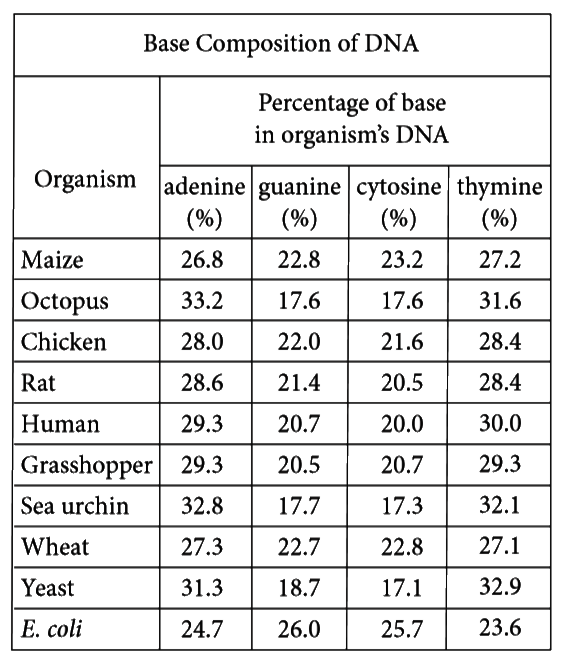
Adapted from Manju Bansal, “DNA Structure: Revisiting the
Watson-Crick Double Helix.” ©2003 by Current Science Association,
Bangalore
29. Do the data in the table support the authors’ proposed pairing of bases in DNA?View SolutionThe chemical formula of deoxyribonucleic acid
(DNA) is now well established. The molecule is a
very long chain, the backbone of which consists of a
regular alternation of sugar and phosphate groups.
5 To each sugar is attached a nitrogenous base, which
can be of four different types. Two of the possible
bases—adenine and guanine—are purines, and the
other two—thymine and cytosine—are pyrimidines.
So far as is known, the sequence of bases along the
10 chain is irregular. The monomer unit, consisting of
phosphate, sugar and base, is known as a nucleotide.
The first feature of our structure which is of
biological interest is that it consists not of one chain,
but of two. These two chains are both coiled around
15 a common fiber axis. It has often been assumed that
since there was only one chain in the chemical
formula there would only be one in the structural
unit. However, the density, taken with the X-ray
evidence, suggests very strongly that there are two.
20. The other biologically important feature is the
manner in which the two chains are held together.
This is done by hydrogen bonds between the bases.
The bases are joined together in pairs, a single base
from one chain being hydrogen-bonded to a single
25 base from the other. The important point is that only
certain pairs of bases will fit into the structure.
One member of a pair must be a purine and the other
a pyrimidine in order to bridge between the two
chains. If a pair consisted of two purines, for
30 example, there would not be room for it.
We believe that the bases will be present almost
entirely in their most probable forms. If this is true,
the conditions for forming hydrogen bonds are more
restrictive, and the only pairs of bases possible are:
35 adenine with thymine, and guanine with cytosine.
Adenine, for example, can occur on either chain, but
when it does, its partner on the other chain must
always be thymine.
The phosphate-sugar backbone of our model is
40 completely regular, but any sequence of the pairs of
bases can fit into the structure. It follows that in a
long molecule many different permutations are
possible, and it therefore seems likely that the precise
sequence of bases is the code which carries the
45 genetical information. If the actual order of the bases
on one of the pair of chains were given, one could
write down the exact order of the bases on the other
one, because of the specific pairing. Thus one chain
is, as it were, the complement of the other, and it is
50 this feature which suggests how the deoxyribonucleic
acid molecule might duplicate itself.
The table shows, for various organisms, the percentage of
each of the four types of nitrogenous bases in that
organism’s DNA.
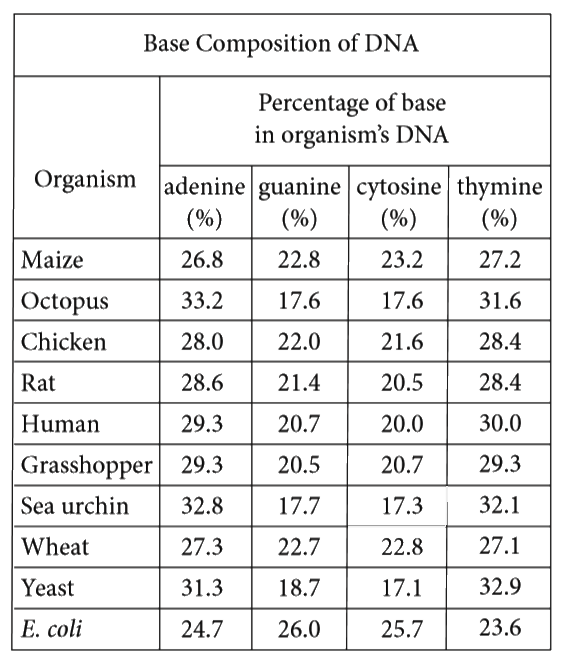
Adapted from Manju Bansal, “DNA Structure: Revisiting the
Watson-Crick Double Helix.” ©2003 by Current Science Association,
Bangalore
22. The authors use the word “backbone” in lines 3 and 39 to indicate thatView Solution
Knowledge Check
- Question 1 - Select One
The chemical formula of deoxyribonucleic acid
(DNA) is now well established. The molecule is a
very long chain, the backbone of which consists of a
regular alternation of sugar and phosphate groups.
5 To each sugar is attached a nitrogenous base, which
can be of four different types. Two of the possible
bases—adenine and guanine—are purines, and the
other two—thymine and cytosine—are pyrimidines.
So far as is known, the sequence of bases along the
10 chain is irregular. The monomer unit, consisting of
phosphate, sugar and base, is known as a nucleotide.
The first feature of our structure which is of
biological interest is that it consists not of one chain,
but of two. These two chains are both coiled around
15 a common fiber axis. It has often been assumed that
since there was only one chain in the chemical
formula there would only be one in the structural
unit. However, the density, taken with the X-ray
evidence, suggests very strongly that there are two.
20. The other biologically important feature is the
manner in which the two chains are held together.
This is done by hydrogen bonds between the bases.
The bases are joined together in pairs, a single base
from one chain being hydrogen-bonded to a single
25 base from the other. The important point is that only
certain pairs of bases will fit into the structure.
One member of a pair must be a purine and the other
a pyrimidine in order to bridge between the two
chains. If a pair consisted of two purines, for
30 example, there would not be room for it.
We believe that the bases will be present almost
entirely in their most probable forms. If this is true,
the conditions for forming hydrogen bonds are more
restrictive, and the only pairs of bases possible are:
35 adenine with thymine, and guanine with cytosine.
Adenine, for example, can occur on either chain, but
when it does, its partner on the other chain must
always be thymine.
The phosphate-sugar backbone of our model is
40 completely regular, but any sequence of the pairs of
bases can fit into the structure. It follows that in a
long molecule many different permutations are
possible, and it therefore seems likely that the precise
sequence of bases is the code which carries the
45 genetical information. If the actual order of the bases
on one of the pair of chains were given, one could
write down the exact order of the bases on the other
one, because of the specific pairing. Thus one chain
is, as it were, the complement of the other, and it is
50 this feature which suggests how the deoxyribonucleic
acid molecule might duplicate itself.
The table shows, for various organisms, the percentage of
each of the four types of nitrogenous bases in that
organism’s DNA.

Adapted from Manju Bansal, “DNA Structure: Revisiting the
Watson-Crick Double Helix.” ©2003 by Current Science Association,
Bangalore
31. Based on the table, is the percentage of adenine in each organism’s DNA the same or does it vary, and which statement made by the authors is most consistent with that data?AThe same, “Two of . . . pyrimidines” (lines 6-8)BThe same, “The important . . . structure” (lines 25-26)CIt varies, “Adenine . . . thymine” (lines 36-38)DIt varies, “It follows . . . information” (lines 41-45) - Question 2 - Select One
The chemical formula of deoxyribonucleic acid
(DNA) is now well established. The molecule is a
very long chain, the backbone of which consists of a
regular alternation of sugar and phosphate groups.
5 To each sugar is attached a nitrogenous base, which
can be of four different types. Two of the possible
bases—adenine and guanine—are purines, and the
other two—thymine and cytosine—are pyrimidines.
So far as is known, the sequence of bases along the
10 chain is irregular. The monomer unit, consisting of
phosphate, sugar and base, is known as a nucleotide.
The first feature of our structure which is of
biological interest is that it consists not of one chain,
but of two. These two chains are both coiled around
15 a common fiber axis. It has often been assumed that
since there was only one chain in the chemical
formula there would only be one in the structural
unit. However, the density, taken with the X-ray
evidence, suggests very strongly that there are two.
20. The other biologically important feature is the
manner in which the two chains are held together.
This is done by hydrogen bonds between the bases.
The bases are joined together in pairs, a single base
from one chain being hydrogen-bonded to a single
25 base from the other. The important point is that only
certain pairs of bases will fit into the structure.
One member of a pair must be a purine and the other
a pyrimidine in order to bridge between the two
chains. If a pair consisted of two purines, for
30 example, there would not be room for it.
We believe that the bases will be present almost
entirely in their most probable forms. If this is true,
the conditions for forming hydrogen bonds are more
restrictive, and the only pairs of bases possible are:
35 adenine with thymine, and guanine with cytosine.
Adenine, for example, can occur on either chain, but
when it does, its partner on the other chain must
always be thymine.
The phosphate-sugar backbone of our model is
40 completely regular, but any sequence of the pairs of
bases can fit into the structure. It follows that in a
long molecule many different permutations are
possible, and it therefore seems likely that the precise
sequence of bases is the code which carries the
45 genetical information. If the actual order of the bases
on one of the pair of chains were given, one could
write down the exact order of the bases on the other
one, because of the specific pairing. Thus one chain
is, as it were, the complement of the other, and it is
50 this feature which suggests how the deoxyribonucleic
acid molecule might duplicate itself.
The table shows, for various organisms, the percentage of
each of the four types of nitrogenous bases in that
organism’s DNA.
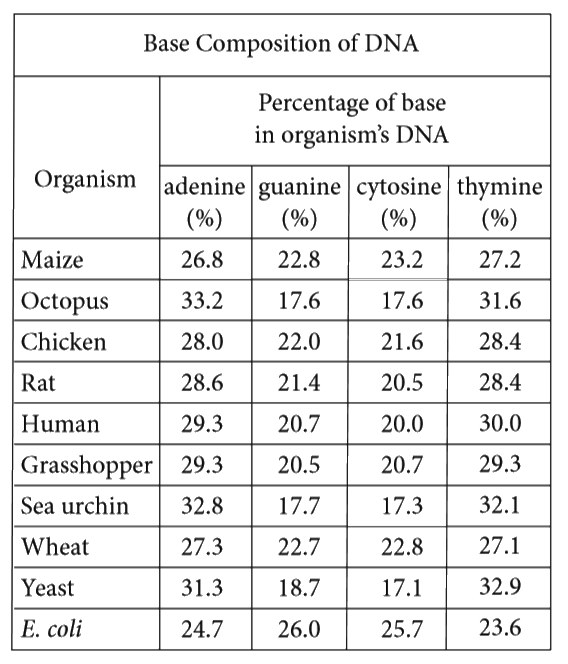
Adapted from Manju Bansal, “DNA Structure: Revisiting the
Watson-Crick Double Helix.” ©2003 by Current Science Association,
Bangalore
25. The authors’ main purpose of including the information about X-ray evidence and density is toAestablish that DNA is the molecule that carries the genetic information.Bpresent an alternate hypothesis about the composition of a nucleotide.Cprovide support for the authors’ claim about the number of chains in a molecule of DNA.Dconfirm the relationship between the density of DNA and the known chemical formula of DNA. - Question 3 - Select One
The chemical formula of deoxyribonucleic acid
(DNA) is now well established. The molecule is a
very long chain, the backbone of which consists of a
regular alternation of sugar and phosphate groups.
5 To each sugar is attached a nitrogenous base, which
can be of four different types. Two of the possible
bases—adenine and guanine—are purines, and the
other two—thymine and cytosine—are pyrimidines.
So far as is known, the sequence of bases along the
10 chain is irregular. The monomer unit, consisting of
phosphate, sugar and base, is known as a nucleotide.
The first feature of our structure which is of
biological interest is that it consists not of one chain,
but of two. These two chains are both coiled around
15 a common fiber axis. It has often been assumed that
since there was only one chain in the chemical
formula there would only be one in the structural
unit. However, the density, taken with the X-ray
evidence, suggests very strongly that there are two.
20. The other biologically important feature is the
manner in which the two chains are held together.
This is done by hydrogen bonds between the bases.
The bases are joined together in pairs, a single base
from one chain being hydrogen-bonded to a single
25 base from the other. The important point is that only
certain pairs of bases will fit into the structure.
One member of a pair must be a purine and the other
a pyrimidine in order to bridge between the two
chains. If a pair consisted of two purines, for
30 example, there would not be room for it.
We believe that the bases will be present almost
entirely in their most probable forms. If this is true,
the conditions for forming hydrogen bonds are more
restrictive, and the only pairs of bases possible are:
35 adenine with thymine, and guanine with cytosine.
Adenine, for example, can occur on either chain, but
when it does, its partner on the other chain must
always be thymine.
The phosphate-sugar backbone of our model is
40 completely regular, but any sequence of the pairs of
bases can fit into the structure. It follows that in a
long molecule many different permutations are
possible, and it therefore seems likely that the precise
sequence of bases is the code which carries the
45 genetical information. If the actual order of the bases
on one of the pair of chains were given, one could
write down the exact order of the bases on the other
one, because of the specific pairing. Thus one chain
is, as it were, the complement of the other, and it is
50 this feature which suggests how the deoxyribonucleic
acid molecule might duplicate itself.
The table shows, for various organisms, the percentage of
each of the four types of nitrogenous bases in that
organism’s DNA.
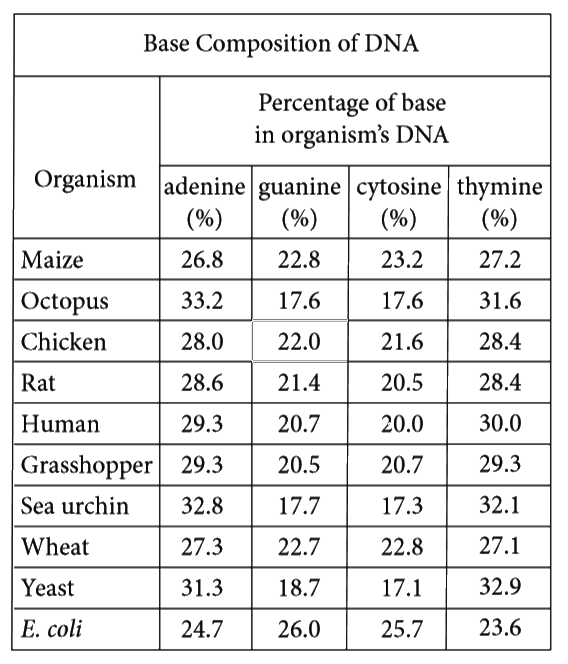
Adapted from Manju Bansal, “DNA Structure: Revisiting the
Watson-Crick Double Helix.” ©2003 by Current Science Association,
Bangalore
24. In the second paragraph (lines 12-19), what do the authors claim to be a feature of biological interest?AThe chemical formula of DNABThe common fiber axisCThe X-ray evidenceDDNA consisting of two chains
The chemical formula of deoxyribonucleic acid
(DNA) is now well established. The molecule is a
very long chain, the backbone of which consists of a
regular alternation of sugar and phosphate groups.
5 To each sugar is attached a nitrogenous base, which
can be of four different types. Two of the possible
bases—adenine and guanine—are purines, and the
other two—thymine and cytosine—are pyrimidines.
So far as is known, the sequence of bases along the
10 chain is irregular. The monomer unit, consisting of
phosphate, sugar and base, is known as a nucleotide.
The first feature of our structure which is of
biological interest is that it consists not of one chain,
but of two. These two chains are both coiled around
15 a common fiber axis. It has often been assumed that
since there was only one chain in the chemical
formula there would only be one in the structural
unit. However, the density, taken with the X-ray
evidence, suggests very strongly that there are two.
20. The other biologically important feature is the
manner in which the two chains are held together.
This is done by hydrogen bonds between the bases.
The bases are joined together in pairs, a single base
from one chain being hydrogen-bonded to a single
25 base from the other. The important point is that only
certain pairs of bases will fit into the structure.
One member of a pair must be a purine and the other
a pyrimidine in order to bridge between the two
chains. If a pair consisted of two purines, for
30 example, there would not be room for it.
We believe that the bases will be present almost
entirely in their most probable forms. If this is true,
the conditions for forming hydrogen bonds are more
restrictive, and the only pairs of bases possible are:
35 adenine with thymine, and guanine with cytosine.
Adenine, for example, can occur on either chain, but
when it does, its partner on the other chain must
always be thymine.
The phosphate-sugar backbone of our model is
40 completely regular, but any sequence of the pairs of
bases can fit into the structure. It follows that in a
long molecule many different permutations are
possible, and it therefore seems likely that the precise
sequence of bases is the code which carries the
45 genetical information. If the actual order of the bases
on one of the pair of chains were given, one could
write down the exact order of the bases on the other
one, because of the specific pairing. Thus one chain
is, as it were, the complement of the other, and it is
50 this feature which suggests how the deoxyribonucleic
acid molecule might duplicate itself.
The table shows, for various organisms, the percentage of
each of the four types of nitrogenous bases in that
organism’s DNA.
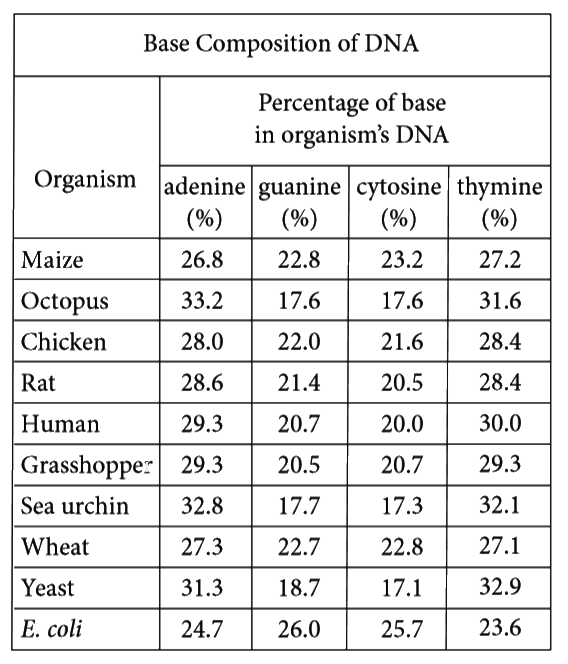
Adapted from Manju Bansal, “DNA Structure: Revisiting the
Watson-Crick Double Helix.” ©2003 by Current Science Association,
Bangalore
23. A student claims that nitrogenous bases pair randomly with one another. Which of the following statements in the passage contradicts the student’s claim?View SolutionIt is often said that India has got the third largest pool of scientific and technological manpower in the world. The harsh truth is that except for a few selected areas, breakthrough in technology including drive for indigenisation have met with limited success. There are neither adequate resources nor proper support to carry out fundamental research, development of indigenous technology or commercialisation of new technology by the Indian industries. The choice of technology and its source is an important aspect as it relates to quality and price of technology. The actual goal of transfer of technology is the establishment of scientific and technological capabilities rather than the mere transfer of plant and equipment. Technology transfer consists of three major components, technology assessment, technology acquisition and assimilation and technology diffusion to local industries after incorporating the necessary degree of modifications. Organisation may lack the professional skills to select a technology thatis suited to local operating conditions and to acquire it on favourable terms. They are guided by past relations, current affiliations and terms and conditions set in the aid package. Thus the technology transfer process becomes often too costly and ineffective. The technologies, which are latest in the field are usually non negotiable and least available for acquisition. Unless the importing organisation ensures the availability of qualified personnel and resources, the technology transfer is bound to suffer or may prove ineffective. Technology transfer could be a multi-edged weapon which, if handled wrongly, may result in expensive/ unwanted imports, hurting the technological progress and ultimately may lead to disaster. Interaction between industry, engineering consultancy organisation, R&D centres and academic institutions is very limited. Industrial/ engineering consultants have limitations of time. By the time a technology is developed, it becomes very costly and sometimes outdated. Due to this reason, industry/engineering consultants have a tendency to avoid academic institutions and R&D centres. As academic institutions and R&D centres do not receive due attention of industries, they prefer working in isolation. The fact remains that the acadernics who do not understand the corporate .world cannot survive and the corporate world that does not use good academic input can't grow. There has to be a mutual appreciation instead of competing, they should complement each other.
Personnel:View SolutionIt is often said that India has got the third largest pool of scientific and technological manpower in the world. The harsh truth is that except for a few selected areas, breakthrough in technology including drive for indigenisation have met with limited success. There are neither adequate resources nor proper support to carry out fundamental research, development of indigenous technology or commercialisation of new technology by the Indian industries. The choice of technology and its source is an important aspect as it relates to quality and price of technology. The actual goal of transfer of technology is the establishment of scientific and technological capabilities rather than the mere transfer of plant and equipment. Technology transfer consists of three major components, technology assessment, technology acquisition and assimilation and technology diffusion to local industries after incorporating the necessary degree of modifications. Organisation may lack the professional skills to select a technology thatis suited to local operating conditions and to acquire it on favourable terms. They are guided by past relations, current affiliations and terms and conditions set in the aid package. Thus the technology transfer process becomes often too costly and ineffective. The technologies, which are latest in the field are usually non negotiable and least available for acquisition. Unless the importing organisation ensures the availability of qualified personnel and resources, the technology transfer is bound to suffer or may prove ineffective. Technology transfer could be a multi-edged weapon which, if handled wrongly, may result in expensive/ unwanted imports, hurting the technological progress and ultimately may lead to disaster. Interaction between industry, engineering consultancy organisation, R&D centres and academic institutions is very limited. Industrial/ engineering consultants have limitations of time. By the time a technology is developed, it becomes very costly and sometimes outdated. Due to this reason, industry/engineering consultants have a tendency to avoid academic institutions and R&D centres. As academic institutions and R&D centres do not receive due attention of industries, they prefer working in isolation. The fact remains that the acadernics who do not understand the corporate .world cannot survive and the corporate world that does not use good academic input can't grow. There has to be a mutual appreciation instead of competing, they should complement each other.
Acquisition:View SolutionIt is often said that India has got the third largest pool of scientific and technological manpower in the world. The harsh truth is that except for a few selected areas, breakthrough in technology including drive for indigenisation have met with limited success. There are neither adequate resources nor proper support to carry out fundamental research, development of indigenous technology or commercialisation of new technology by the Indian industries. The choice of technology and its source is an important aspect as it relates to quality and price of technology. The actual goal of transfer of technology is the establishment of scientific and technological capabilities rather than the mere transfer of plant and equipment. Technology transfer consists of three major components, technology assessment, technology acquisition and assimilation and technology diffusion to local industries after incorporating the necessary degree of modifications. Organisation may lack the professional skills to select a technology thatis suited to local operating conditions and to acquire it on favourable terms. They are guided by past relations, current affiliations and terms and conditions set in the aid package. Thus the technology transfer process becomes often too costly and ineffective. The technologies, which are latest in the field are usually non negotiable and least available for acquisition. Unless the importing organisation ensures the availability of qualified personnel and resources, the technology transfer is bound to suffer or may prove ineffective. Technology transfer could be a multi-edged weapon which, if handled wrongly, may result in expensive/ unwanted imports, hurting the technological progress and ultimately may lead to disaster. Interaction between industry, engineering consultancy organisation, R&D centres and academic institutions is very limited. Industrial/ engineering consultants have limitations of time. By the time a technology is developed, it becomes very costly and sometimes outdated. Due to this reason, industry/engineering consultants have a tendency to avoid academic institutions and R&D centres. As academic institutions and R&D centres do not receive due attention of industries, they prefer working in isolation. The fact remains that the acadernics who do not understand the corporate .world cannot survive and the corporate world that does not use good academic input can't grow. There has to be a mutual appreciation instead of competing, they should complement each other.
Affiliations:View SolutionIt is often said that India has got the third largest pool of scientific and technological manpower in the world. The harsh truth is that except for a few selected areas, breakthrough in technology including drive for indigenisation have met with limited success. There are neither adequate resources nor proper support to carry out fundamental research, development of indigenous technology or commercialisation of new technology by the Indian industries. The choice of technology and its source is an important aspect as it relates to quality and price of technology. The actual goal of transfer of technology is the establishment of scientific and technological capabilities rather than the mere transfer of plant and equipment. Technology transfer consists of three major components, technology assessment, technology acquisition and assimilation and technology diffusion to local industries after incorporating the necessary degree of modifications. Organisation may lack the professional skills to select a technology thatis suited to local operating conditions and to acquire it on favourable terms. They are guided by past relations, current affiliations and terms and conditions set in the aid package. Thus the technology transfer process becomes often too costly and ineffective. The technologies, which are latest in the field are usually non negotiable and least available for acquisition. Unless the importing organisation ensures the availability of qualified personnel and resources, the technology transfer is bound to suffer or may prove ineffective. Technology transfer could be a multi-edged weapon which, if handled wrongly, may result in expensive/ unwanted imports, hurting the technological progress and ultimately may lead to disaster. Interaction between industry, engineering consultancy organisation, R&D centres and academic institutions is very limited. Industrial/ engineering consultants have limitations of time. By the time a technology is developed, it becomes very costly and sometimes outdated. Due to this reason, industry/engineering consultants have a tendency to avoid academic institutions and R&D centres. As academic institutions and R&D centres do not receive due attention of industries, they prefer working in isolation. The fact remains that the acadernics who do not understand the corporate .world cannot survive and the corporate world that does not use good academic input can't grow. There has to be a mutual appreciation instead of competing, they should complement each other.
Indigenisation:View Solution

